Coastal Inundation Forecasting Demonstration Project (CIFDP)
Jump to: Introduction | Project Description | Sub Projects | Steering Group | Meetings and Reports
Introduction
Coastal inundations are an increasing threat to the lives and livelihoods of people living in low-lying, highly populated coastal areas. The management of such risk represents a great challenge to scientists and policymakers in the areas of meteorology, hydrology, oceanography, emergency management and coastal planning.
With a view to improving safety-related services for the community, as a fundamental priority of the WMO, in 2009, the former Joint WMO-IOC Technical Commission for Oceanography and Marine Meteorology (JCOMM) and the former WMO Commission for Hydrology (CHy) initiated the Coastal Inundation Forecasting Demonstration Project (CIFDP) in order to meet the challenges of coastal communities’ safety and socio-economic sustainability through the development of coastal inundation forecasting and warning systems at the regional scale.
The WMO Executive Council, at its 62nd session (Geneva, June 2010), emphasized the importance of a comprehensive and integrated approach for marine multi-hazard forecasting and warning systems, for improved coastal risk management. In this context, this demonstration project was initiated for building improved operational forecasts and warnings capability for coastal inundation from combined extreme waves, surges, and river flooding events.
The CIFDP aimed to provide an example of cooperative work as a strategy for building improved operational forecast and warning capability for coastal inundation from combined extreme waves, surges, and river flooding events, that can be sustained by the responsible national agencies. The focus of the CIFDP was to facilitate the development of efficient forecasting and warning systems for coastal inundation based on robust science and observations. The CIFDP should:
- Identify and support end-user needs. In this context, full engagement of the stakeholders and partners in the CIFDP from early stages is critical for the successful development and implementation of this project;
- Support informed decision-making on warning issuance and dissemination (that includes information on land-use and planning) in coastal zones;
- Transfer and translate science and technology to communities (technology development and transfer);
- Facilitate the development of a comprehensive Storm Surge Watch Scheme (SSWS) in basins subject to tropical cyclones and storm surges, jointly with (fluvial) flood events;
- Facilitate the development and implementation of warning services;
- Support coastal risk assessment, hazard and risk mapping.
A general strategy for a Coastal Inundation Forecasting Demonstration Project (CIFDP) was adopted at the fourth session of JCOMM (May 2012, Republic of Korea), as follows:
- The Project would be implemented under each regional/national sub-project, launched for a country that meets the essential requirement for initiating a national agreement between national institutions with relevant responsibilities, and the provisional establishment of a National Coordination Team (NCT) that includes operator(s) of the National Meteorological and Hydrological Service (NMHS);
- The Project would be designed based on users’ perspectives and requirements, considering only existing and available open-source techniques. Final products of the Demonstration Project should be operated and maintained by a national operational agency which has the responsibility/authority for storm surge warning and flood warning;
- The procedure/best practice developed through a sub-project should be applicable to other (neighbouring) countries with common issues and interests and should be closely linked to, and cooperating with, related projects and activities, such as WMO’s regional Severe Weather Forecasting Demonstration Project (SWFDP) in building a “cascading forecasting process” to produce services for coastal zones.
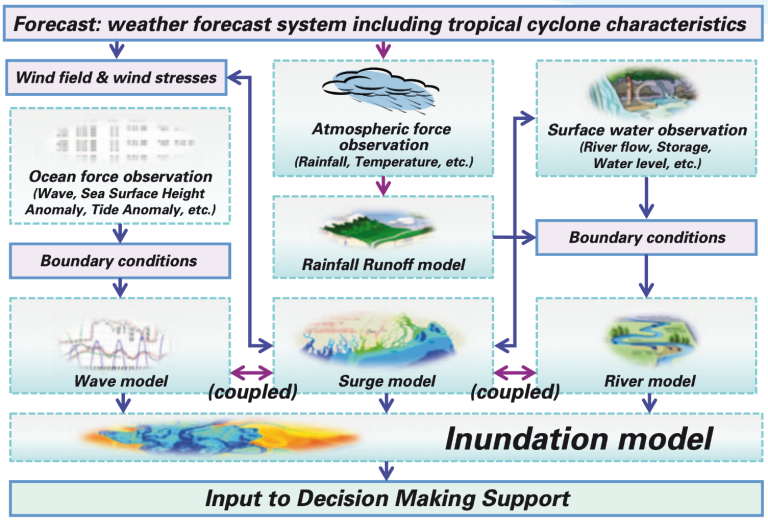
Diagram of the CIF-EWS main modelling components (WMO, 2013a)
CIFDP was implemented through national sub-projects initiated by countries, with leadership and participation from operational forecast agency(ies) and in close coordination with the national coastal disaster management authorities. A critical part of the CIFDP effort was to provide evidence that the forecast system is suitably validated. This requires:
- a comparison of modeling system performance relative to available observations in past events;
- a demonstration that the system is suitably robust to maintain functionality for the complete range of storms (extreme events) and boundary conditions critical to inundation in an area; and
- a demonstration that the system is capable of providing information needed by local stakeholders and that this system adequately addresses the uncertainty in the forecast surges.
Upon completion of Sub-Projects of CIFDP, countries implemented an operational system for integrated coastal inundation forecasting and warning, providing an objective basis for coastal disaster (flooding) management, contributing to saving lives, reducing loss of livelihood and property, and enhancing resilience and sustainability in coastal communities. Each Phase of the Project provided implementing countries with valuable input and experience regarding the assessment and awareness of the issues of coastal inundation management within its governments. It also assisted the countries to advance steps toward integrated forecasting warning services.
The CIFDP is now completed. A thorough review of the concept is contained in the October 2019 issue of the WMO Bulletin, detailing the 10-year history of the Demonstration Project from its inception in 2009.
In 2018, WMO commissioned an independent review (Barrett and Canterford, 2018) of CIFDP that provided a thorough assessment of the innovative concept of the demonstration project with various conclusions and recommendations. The review confirmed that the sub-projects had been successful in demonstrating the ability to make impact-based forecasts and warnings for coastal inundation when there are complex combinations of forcing mechanisms. The review found that there would be benefits to extending and enhancing CIFDP approaches in other vulnerable developing countries. For example, the Fiji subproject provided an excellent model for application to other small island environments in the South Pacific, while the Hispaniola case can be readily adapted to other Caribbean islands. The implementation in Bangladesh could be applied to other countries around the Bay of Bengal, and the Indonesia study, which focused on the cities of Jakarta and Semarang, could be implemented for other locations in Indonesia or neighbouring countries.
The Eighteenth Session of the World Meteorological Congress endorsed the main findings and recommendations of the review and removed the “demonstration” tag to create a new programme: Coastal Inundation Forecasting Initiative (CIFI). CIFI fits the concept of a Multi-Hazard Early Warning System (MHEWS) advocated in the Sendai Framework for Disaster Risk Reduction. Thus, it will seek out synergies where possible, including with tsunami early warning processes.
The successful completion of CIFDP has demonstrated the value of designing early warning systems with flexibility to account for inundation from multiple sources. Over the decade 2009 to 2019, the dedicated efforts of Members working together with their partners in the participating countries as well as of the former JCOMM, CHy and many other experts has demonstrated the value of an innovative early warning system and the value of interdisciplinary collaboration at an international scale for the greater good of public safety.
Casualties by Cyclones and Storm Surges
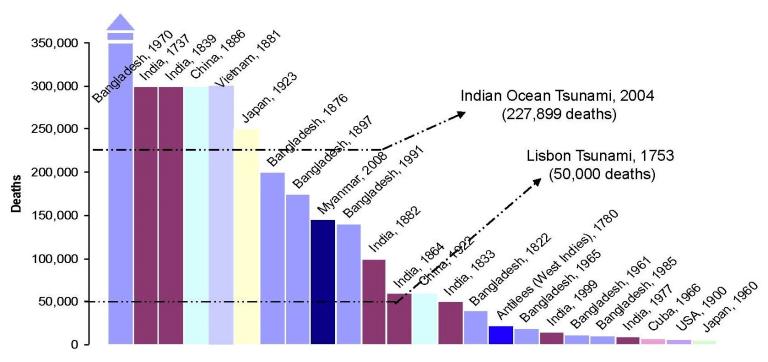
Deaths in tropical cyclones in each year, for highest ranks in history (with indication of relative level of casualties in major tsunami events). Most fatalities in tropical storms are due to storm surges. All casualty figures are estimates and vary widely according to sources. (Dube, 2007)
Global Distribution of Flood Risk (Mortality)

Global Distribution of Cyclone Risk (Mortality)

World Bank. (Dilley, Maxx; Robert S. Chen, Uwe Deichmann, Arthur L. Lerner-Lam, and Margaret Arnold, with Jonathan Agwe, Piet Buys, Oddvar Kjekstad, Bradfield Lyon, and Gregory Yetman). 2005. Natural Disaster Hotspots: A Global Risk Analysis.
Project Description
The following sections describe the general guidance for the national implementation of CIFDP sub-projects in place at the time of the projects.
Objectives and Scope
The CIFDP aims to assist countries with issues of coastal inundation from oceanographic and/or hydrological phenomena, resulting from severe hydrometeorological events, to operate and maintain a reliable forecasting system that helps the national decision-making for coastal management, through:
- Identifying the national and regional requirements;
- Implementing open-source coastal inundation end-to-end operational forecasting and warning systems;
- Developing cross-cutting cooperation among different scientific disciplines and user communities;
- Building communication platforms between researchers, forecasters and disaster managers involved in coastal inundation management;
- Providing specialized training for operators, forecasters and disaster managers.
The focus of the CIFDP will be to facilitate the development of efficient forecasting and warning systems for coastal inundation based on robust science and observations. The CIFDP should:
- Identify and support end-user needs;
- Encourage full engagement of the stakeholders and partners in the CIFDP from early stages, for the successful development and implementation of national sub-projects;
- Transfer technology to the adopting countries;
- Facilitate the development of a comprehensive Storm Surge Watch Scheme (SSWS) in basins subject to tropical cyclones and storm surges, jointly with (fluvial) flood events;
- Facilitate the development and implementation of warning services;
- Support coastal risk assessment, vulnerability and risk mapping to be used by national disaster management authorities, and for the development of integrated coastal zone management plans;
- Assist improved and informed decision-making for coastal inundation management.
Expected Outcome and Deliverables
The major expected outcomes of the CIFDP include the following:
- Technology development and transfer, including training, which would enhance the capabilities of responsible national agencies to produce and provide integrated coastal inundation forecasting and warning services;
- Established procedures, best practices and outcomes of CIFDP will serve as guidelines to other countries to develop and improve their related service capabilities, and furthermore, contribute to building specific criteria for designated WMO Regional Specialized Meteorological Centres (RSMCs) to provide NMHSs with advice on coastal inundation forecasting and warnings;
- CIFDP implementation would create synergies with ongoing regional and global programmes and activities; for example, enhancing effective use of improved Numerical Weather Prediction (NWP) products by building a “cascading forecasting process” for coastal processes with the WMO Severe Weather Forecasting Demonstration Project (SWFDP), and providing technical requirements to develop the regional SSWS;
- Communication platforms, which would improve interactions of responsible national agencies and partners (e.g. governmental forecasting agencies, agencies responsible for disaster management, Civil Protection Agencies, media), will provide a mechanism for continuous improvement in updating user requirements, technical needs, and user feedback.
Strategic Approach for Project Implementation
The general strategy for CIFDP, as adopted by the 4th session of JCOMM (May 2012, Yeosu, Republic of Korea), is as follows:
- The Project would be implemented under each regional/national Sub-Project, launched for a country that meets the essential requirement. This implies initiation of a national agreement between national institutions with relevant responsibilities, and the establishment of a National Coordination Team (NCT) led by the national operational agency responsible for coastal inundation forecasting, usually a NMHS;
- The Project would be designed based on users’ perspectives, requirements and capacities, considering existing and available open-source techniques. Final products of the Demonstration Project should be operated and maintained by national operational agencies which have the responsibility/authority for coastal inundation warnings;
- The procedures/best practices developed through Sub-Projects should be applicable to other (neighbouring) countries with common issues and interests, and should be closely linked to and cooperating with related projects and activities.
The Sub-Projects of CIFDP are to be implemented in a phased approach, which provides an opportunity to adjust the scope of the next phases to fit the prevailing requirements. Not only the final results of the Project, but the accomplishment of each phase will also serve the target country as a useful exercise to raise the issue of coastal inundation management within its governments and among a wide range of multidisciplinary communities, and to take steps toward integrated forecasting and warning services.
National Commitment
CIFDP is implemented through each Sub-Project initiated by a country, with leadership and participation from operational forecast agency(ies), with the following requirements:
- Given mandates/responsibilities for coastal inundation forecasting and warning services;
- Availability of qualified staff to run the system in 24/7 mode, with appropriate infrastructure for operational services, including sufficient computing power and communication bandwidth to run the operational systems;
- Commitment to sharing all data and information relevant to the inundation forecast process.
In the framework of JCOMM and CHy, the NMHS in cooperation with other national stakeholders, should play a key role in developing, implementing and applying the results of this Project. The NMHS and other national stakeholders, including responsible national agencies, will establish a Sub-Project National Coordination Team (NCT) to lead the Sub-Project implementation, with guidance by the PSG for each Phase. Close cooperation with the national authorities for coastal disasters risk and emergency management, as well as other stakeholders, will ensure that user requirements are fully taken into account in the technical development.
It is strongly recommended that members of a NCT, particularly those of the NMHSs and other responsible forecasting agencies, are selected with a view of their continuing involvement in all Phases of the Sub-Project implementation, to ensure the efficient and effective implementation of the Project.
User commitment is key; to ensure usability and sustainability of the outcome/results of the project, the end users will be involved from the early phases of project planning. The national and regional implementers should play the leading role in identifying users and user requirements
CIFDP Project Implementation
The Project for each region/country will be implemented in a phased approach that leaves scope for adjustment in the next phases to fit the prevailing requirements:

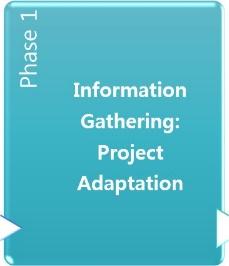

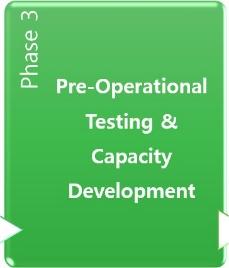

|
Phase 0: Project Preparation
Before the actual start of the CIFDP, an Initial National Agreements at the political level should be prepared:
- based on a high-level definition of the operational scope for the national sub-projects;
- to ensure commitment and coordination of the national agencies;
- to ensure free and open exchange of data and information required for implementing a coastal inundation forecast project.
Phase 1: Information Gathering - Project Adaptation
Initial Assessment:
- Assess and describe national capabilities in the fields of coastal flood risk, inundation forecasting and related emergency management structures;
- Compile a high-level inventory of the institutional end-users’ information and communication needs for emergency management during extreme coastal flooding events - initial User Requirements Plan (URP), to be updated through all Phases of implementation;
- Combining both assessments will demonstrate where the CIFDP could provide added value.
A Stakeholders Workshop is a key milestone in Phase 1 to deliver the outcomes of Phase 1. It also contributes to the following objectives:
- wider introduction of the CIFDP;
- information collection on stakeholder needs and requirements;
- obtaining agreement and commitment on the project objectives;
- interaction with and input from RSMC and other relevant data producing agencies will be actively sought and encouraged.
Definitive National Agreement (DNA):
Based on the initial/updated sub-project plan arising from the Stakeholder Workshop(s), a definitive commitment is to be obtained from the national government including the responsible national forecasting/warning agencies, to carry out the subsequent phases of the CIFDP Sub-Project, to ensure a long-term coordination between the national agencies within the National Coordination Team (NCT).
Sub-project National Coordination Team (NCT):
Based on the updated Project Plan at the Workshop(s), the membership and a Terms of Reference (ToR) will be agreed along with the DNA, responsible for the timely project implementation at the national level under the guidance and advice of the PSG.
National Capacity Assessment (NCA) and User Requirements Plan (URP):
- Following the Stakeholders Workshop, a full information collection should be undertaken by the NCT. The National Capacity Assessment (NCA) is a review of the existing technical capacity and capability within a country, as it will be applied to the development of a sustainable, operational coastal inundation forecasting system. It should particularly address the gaps in the present capacity and what is required to implement a robust and accurate forecast system.
- In parallel with the NCA, identification and documentation of user requirements should be carried out on a continuous basis through the User Requirements Plan (URP); to take into account the needs of disaster management agencies, emergency measures organizations, disaster risk reduction initiatives, of relevant national, regional and international agencies.
Development of Sub-Project Plan (by NCT):
Based on the results from the Stakeholders Workshop(s) and follow-up, the sub-project plan will be documented by the NCT, describing:
- definition of organizational setting, and assessment of responsibilities;
- current status of technical and institutional capabilities, gaps and needs (cross-reference to the NCA);
- initial specification for forecasting/warning models and system components, and associated requirements (to be basis of the System Design in Phase 2);
- working arrangement for sub-project implementation;
- plans to identify financial and human resources required for project implementation (e.g. draft funding proposal).
Project Phase 1 Review and Approval (by PSG):
The compiled deliverables of Phase 1- including the DNA (and the establishment of NCT), NCA, URP and sub-project plan - will be reviewed by the PSG, to decide upon the proceeding to the next phase of the project.
Phase 2: System Implementation
Implementation Kick-off
Prior to implementation, a kick-off meeting will be held to confirm the system implementation approach and the forecasting system setup, as defined in the updated implementation plan. The outcome should include the System Design / specification for national coastal inundation forecasting (CIF) system, and updated URP. The system developer(s) should be selected and agreed through this meeting. The sub-project Plan is to be updated according to the development of the project.
Model & System Development
At this stage, the system developer(s) should work with the NCT in consultation with the PSG to carry out / implement a (pre-)operational forecasting system, as agreed through the System Design.
- Building (Pre-)Operational Forecasting System
- Hardware setup
- System Testing and Exercise (pre-test as a demonstration)
User Products
Feedback both from system operators (forecasters) and users of the CIF information should be collected and documented, as part of implementation and evaluation of the project, based on the URP.
Development of coastal inundation scenarios (based on historical events) will be carried out in collaboration with disaster management authorities, following existing guidelines.
Capacity Development and Training
Throughout the system implementation phase, appropriate training for system operators/professionals should be carried out. Training at this stage will be the basis of more extensive formal training in Phase 2, targeting forecasters/operators and CIFDP focal points, operators of key NCT members/institutions, system operators of neighbouring countries (as potential users) and operators of other CIFDP sub-projects.
Sub-Project Plan Update
Based on the results from the implementation of the prototype, the sub-project plan will be updated and detailed for the remaining phases of the CIFDP. It is expected to include:
- acceptance testing plan
- plan for the operational system set-up
- input/addition/edition to User Requirement Document
- human resource development and training plan
Project Phase 2 Review and Approval (by PSG)
The compiled deliverables of Phase 2- Implementation report (by System Developer(s) and NCT) including the progress report and pre-test results, updated sub-project plan, updated URP - will be reviewed by the PSG, to decide upon the proceeding to the next phase of the project.
Phase 3: Pre-Operational Testing & Capacity Development
The objective of Phase 3 is to transfer the developed tools and methods in the previous phase to an operational forecasting and warning system. It should include development of operational procedures, development of service products for coastal inundation management, acceptance testing and capacity development. A major event in this phase of the project is the simulation of an extreme inundation event using CIF technology involving all key stakeholders from the forecasters to the end users at local level. Phase 3 should be concluded with the CIF system going live at the national level.
Developing System User Guidelines
User and support documentation should be completed at this stage, documenting procedures and best practices to use the developed CIF tools for issuing forecasts and warnings.
Further Training Material and Capacity Development
An important part of training for operators ("on-the-job" training) will have taken place in Phase 2. In this Phase, the task should focus on formal training of national agency professionals and key stakeholders, on the operation / maintenance / future development of the CIF technology, and on the use of forecasting products in inundation management procedures.
Acceptance Testing
A formal acceptance procedure will be followed to test whether the developed system is ready to be used operationally. The test procedure will have been specified under Phase 2.
End-to-End Forecasting Simulation Event
A major milestone for Phase 3 is the simulation of an extreme inundation event using CIF technology, involving all key stakeholders from the forecasters to the end users at local level.
Handover and Going Live
Project Phase 3 Review and Approval (by PSG)
The compiled deliverables of Phase 3- results of the simulation test, system user guidelines and sub-project plan - will be reviewed by the PSG, to decide upon the proceeding to the next phase of the project.
Phase 4: Live Running & Evaluation
The CIF system is ready to be in operation at this Phase. The Project will focus on accommodating user requirements and change requests at this Phase. Through national/international demonstration and discussion, the implementing country and PSG will complete the project evaluation, and build an outlook to future benefits and enhancements
System Updates, Support & Maintenance
Follow-up training
Project evaluation workshop & international conference
Project wrap-up
Sub Projects
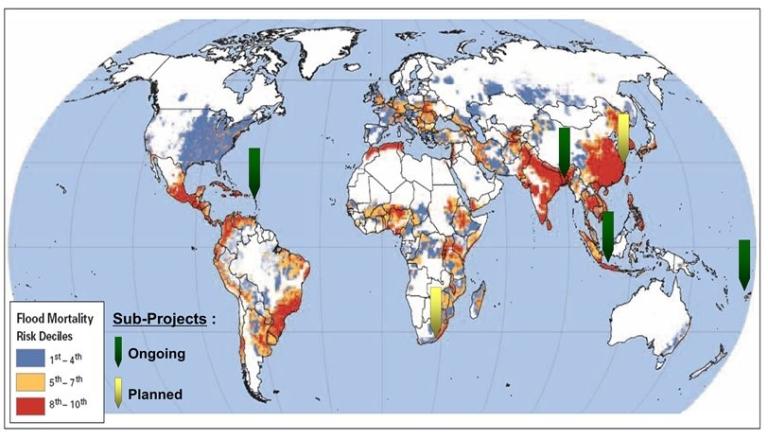
CIFDP Sub Projects
Considering that the CIFDP addresses both institutional and technical aspects relating to the operational coastal inundation forecasting and warning, which would be an essential part of the disaster management in the country, the Project is being implemented under each Sub-Project launched for a country that meets the essential requirements.
Countries that intend to develop a sub-project are invited to prepare and deliver to WMO an Initial National Agreement between participating national agencies responsible for coastal inundation forecasting and warning, to be the basis of a Definitive National Agreement (DNA).
The overall project concept for each Sub-Project should not be limited to the country itself but approached regionally. The developed procedure/best practice through a Sub-Project should be applicable to other (neighbouring) countries with common issues and interests.
Completed Sub-Projects:
- Bangladesh (CIFDP-B), with support of USAID
- Fiji (CIFDP-F), with support of KOICA and KMA
- Caribbean (CIFDP-C), with support of USAID
- Indonesia (CIFDP-I)
Details on the four completed sub-projects are available in the individual final reports and the summary in the WMO Bulletin 68(2).
Steering Group
The CIFDP is under the oversight of the Project Steering Group (PSG) for overall project planning, implementation, review progress and reporting. The PSG works closely with the WMO Secretariat and with the Sub-Project National Coordination Teams (NCTs) to ensure that each Sub-Project is implemented in line with the overall Project Framework that was endorsed by the WMO Congress and its technical commissions including the Joint WMO-IOC Technical Commission for Oceanography and Marine Meteorology (JCOMM) and Commission for Hydrology (CHy).
The PSG works with the WMO Secretariat in:
- regular review and update of the Project Concept, Implementation Plan and Technical Recommendation: Forecast System Concept;
- initiation of Sub-Projects, by reviewing the initial requirements and providing advice to the countries and WMO technical commissions (JCOMM and CHy);
- reviewing progress of Sub-Projects in each phase, and providing recommendations to JCOMM and CHy regarding the following steps of the Sub-Project implementation.
The PSG works closely with each Sub-project National Coordination Team (NCT), in:
- selecting technical solutions for the storm surge, wave and hydrological forecasting and operation, which meet the national and regional capabilities and requirements;
- providing guidance to the development and implementation of Sub-Project Plan, including technical development as well as stakeholder interactions and consultations;
- developing modalities for interactions with, and input from, associated projects;
- issuing the final review report on the Sub-Project and preparing recommendations to be transmitted to the relevant bodies.
The PSG is comprised of experts on coastal inundation (e.g. storm surge, wave and hydrological modelling and forecasting) and associated areas (e.g. service delivery and social science).
The PSG collaborates with the JCOMM Expert Team on Waves and Coastal Hazard Forecasting Systems (ETWCH), by working closely with at least one ETWCH member for each Sub-Project implementation, to address technical aspects of metocean modelling and operational coastal hazard forecasting and warning.
The PSG collaborates with the WMO Working Group on Societal and Economic Research Applications (WG-SERA), by making a linkage with at least one SERA member for each Sub-Project implementation, to address user requirements and socio-economic aspects.
The ToR, as well as the membership of the PSG, are regularly reviewed and updated as necessary at each PSG meeting.
Membership:
- Mr Val Swail (co-chair) – Meteorological modelling and forecasting expert
- Dr Yuri Simonov (co-chair) – Hydrometeorological modelling and forecasting expert
- Dr Don Resio - Meteorological modelling and forecasting expert
- Dr Linda Anderson-Berry - Social science expert
- Dr Paul Davies - Hydrometeorological modelling and forecasting expert
- Dr Monika Donner - Hydrological modelling and forecasting expert
- Mr Nadao Kohno - Metocean modelling and forecasting expert
- Dr Paula Etala - Meteorological modelling and forecasting expert
- Dr S.H.M Fakhruddin - Hydrological modelling and forecasting expert
- Mr Jamie Rhome – Meteorological modelling and forecasting expert
- Mr Deepak Vatvani – Hydrological and metocean modelling expert
Meetings and Reports
https://community.wmo.int/activity-areas/Marine/Pubs/JCOMM-Services#CIFDP
Return to WMO Marine homepage
